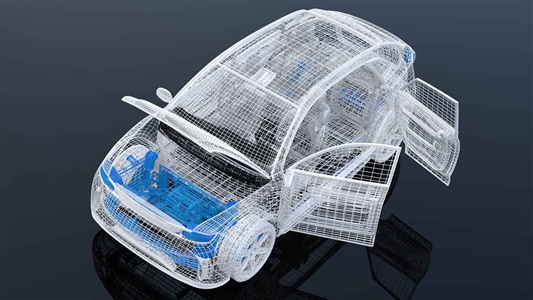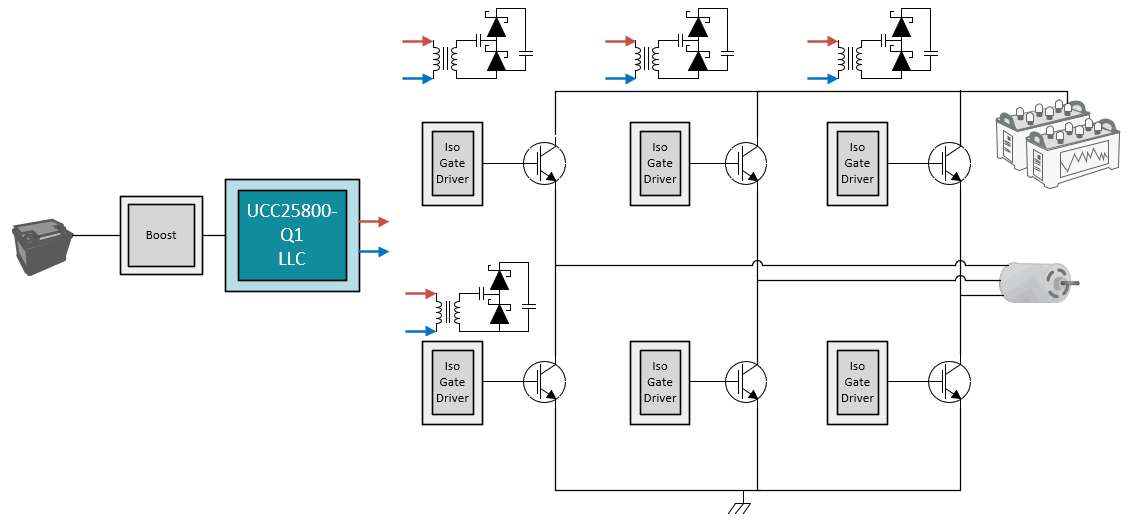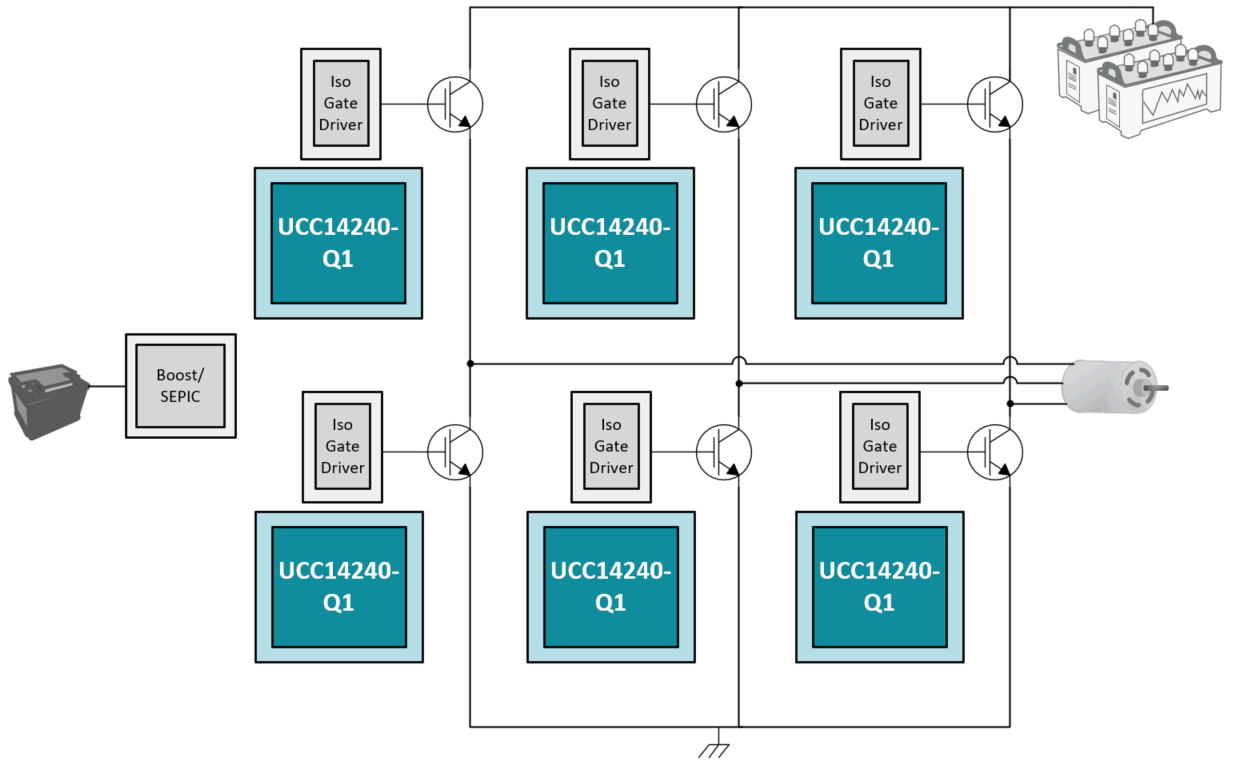SSZT131 september 2021 UCC14130-Q1 , UCC14131-Q1 , UCC14140-Q1 , UCC14141-Q1 , UCC14240-Q1 , UCC14241-Q1 , UCC14340-Q1 , UCC14341-Q1 , UCC15240-Q1 , UCC15241-Q1 , UCC5870-Q1
John Stevens

Electric vehicles (EVs) and hybrid EVs (HEVs) are changing, as are the electronics inside them. The increasing amount of electronics plays a significant role in the overall form and function of these vehicles. Drivers, however, haven’t changed; they still expect their EVs and HEVs to drive further without stopping, become more affordable, charge faster, and keep them safe. But how can designers give them more, for less?
With more stringent requirements for safety, power density and electromagnetic interference (EMI), different power architectures have emerged to address these challenges, including a distributed power architecture with an individual bias supply for each critical load.
Traditional Bias Power Architectures in EVs
Automotive design engineers can design schemes for certain power architectures based on the EV’s power-supply requirements. The traditional approach shown in Figure 1 is a centralized power architecture, which uses one central transformer and a single bias controller to generate the bias voltages for all gate drivers.
 Figure 1 A Centralized Architecture in an HEV/EV Traction Inverter
Figure 1 A Centralized Architecture in an HEV/EV Traction InverterCentralized architectures have been a popular solution historically given their low cost, but this architecture can make it difficult to manage faults and regulate the voltage, along with being challenging to lay out. A centralized architecture can be susceptible to more noise as well, and have tall and heavy components in one area of the system.
Finally, as reliability and safety become a priority, a centralized architecture’s supplies lack redundancy and could result in large system failures if a single component were to fail in the bias supply. Implementing a distributed architecture for protection against power-supply failures will achieve a reliable system.
Enabling High Reliability with a Distributed Architecture
If a small electronic component fails in a traction inverter motor while the car is going 65 mph, no one wants the vehicle to suddenly come to a complete stop or lose engine power. Redundant and backup power supplies within the powertrain have become the norm to ensure safety and reliability.
A distributed power architecture meets the reliability standards of an EV’s environment by assigning each gate driver a dedicated, local, well-regulated bias power supply in close proximity. This architecture provides redundancy and improves how the system reacts to single-point failures. For example, if one bias supply paired to a gate driver fails, the other five bias supplies remain operational, as do their paired gate drivers. If five of the six gate drivers remain operational, the motor can slow and shut down in a well-controlled manner, or potentially continue operating indefinitely. Passengers in the vehicle may not even recognize a disturbance with such a power system design.
The large height, weight and area of external transformer bias supplies such as flybacks and push-pull controllers prevent the use of a distributed architecture in lightweight electronics. The EV power system requires something more advanced – a smaller integrated transformer module such as the UCC14240-Q1 isolated DC/DC bias supply module, which integrates the transformer and components into one optimized module solution with low-height planar magnetics.
Integrating the planar transformer in an integrated circuit-sized package makes it possible to drastically reduce the size, height and weight of the power system. The UCC14240-Q1’s integration of the transformer and isolation offers easy control and low primary-to-secondary capacitance, improving common-mode-transient immunity (CMTI) in dense and fast-switching applications. Fully integrating the primary- and secondary-side control with the isolation achieves a regulated ±1.3% isolated DC/DC bias supply all in one device. By achieving 1.5 W of output power, even up to 105°C, the UCC14240-Q1 can power a gate driver in a distributed architecture, as shown in Figure 2.
 Figure 2 A Distributed Architecture in an EV/HEV Traction Inverter Using the UCC14240-Q1
Figure 2 A Distributed Architecture in an EV/HEV Traction Inverter Using the UCC14240-Q1Other Considerations for Driving Powertrain Systems in a Distributed Architecture
EVs require a high standard of reliability and safety, and that requirement trickles down to individual power-conversion electronics. Components must operate in a controlled and proven manner in ambient temperatures of 125°C and beyond. The isolated gate drivers are “smart” and include several safety and diagnostic features. The low-power bias supplies powering the gate drivers and other electronics in the system require advancements as well, including ways to achieve low EMI. By leveraging TI’s integrated transformer technology and a low 3.5-pF primary-to-secondary capacitance transformer, the UCC14240-Q1 can mitigate EMI caused by high-speed switching and comfortably achieve CMTI of more than 150 V/ns.
The proximity of the bias supply to the isolated gate driver in a distributed architecture ensures a simpler printed circuit board layout and better regulation of the voltage powering the gate driver, ultimately driving the gate of the power switches. These factors lead to better efficiency and reliability of the traction inverter, which can typically operate at 100 kW to 500 kW. These high-power systems demand the highest efficiency to ensure minimal heat loss, since thermal stress is one of the main culprits of component failure.
As these EV power systems move to higher power, it’s time to consider silicon carbide and gallium nitride power switches to enable smaller and more efficient power supplies. Both semiconductor technologies have several benefits, but require more tightly regulated gate-driver voltages than mature, legacy insulated gate bipolar transistors. They also require components offering low capacitance across the safety isolation barrier and high CMTI, because they switch high voltages at faster edge rates than previously thought possible.
Moving to a Reliable, Long-range Future for EVs
Drivers will continue to demand vehicles with lower emissions, longer ranges, better safety and reliability, and generally more features for less money. Only advances in power electronics can make these demands possible in EVs, including innovations in power architectures and their associated isolated gate drivers and bias supplies.
The move to a distributed power architecture greatly increases reliability in isolated high-voltage environments, but comes with the challenge of increased size and weight from the additional components. Fully integrated power solutions such as the UCC14240-Q1 bias supply module, which switches at high frequencies, can provide both system-level space and weight savings.
Additional Resources
- Check out these white papers:
- Download the UCC14240-Q1 data sheet.
- Download the UCC5870-Q1 data sheet.
- Read the technical article, “The value of a thin, isolated power solution.”
- To learn more about TI’s full portfolio of power and signal isolation technologies and how they deliver the industry’s highest isolation ratings and device lifetimes, see www.ti.com/isolation.